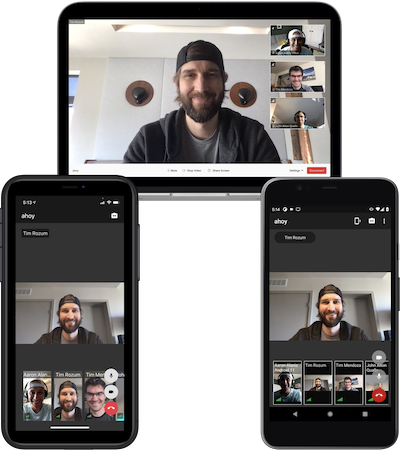Live Version: Here
NOTE - If the link asks for password in landing page, it is '90344501094335'. Twilio deployment has added the passcode feature for security purposes. Without it, anyone can use the video app and incur charges on my Twilio account. Also, it needs redeployment every week as the password get expired after every week.
Multi User Video Chat Application built with Twilio's Programmable Video JS SDK, Twilio's Conversations JS SDK, and Create React App.
The Video app has the following features:
✔️ Video conferencing with real-time video and audio
✔️ Chat support for textual and file-based messaging
✔️ Enable/disable camera
✔️ Mute/unmute mic
✔️ Screen sharing
✔️ Dominant speaker indicator
✔️ Network quality indicator
✔️ Defines participant bandwidth usage with the Bandwidth Profile API
You must have the following installed:
- Node.js v12+
- NPM v6+ (comes installed with newer Node versions)
Run npm install to install all dependencies from NPM.
If you want to use yarn to install dependencies, first run the yarn import command. This will ensure that yarn installs the package versions that are specified in package-lock.json.
The app is deployed to Twilio using the Twilio CLI. Install twilio-cli with:
$ npm install -g twilio-cli
Login to the Twilio CLI. You will be prompted for your Account SID and Auth Token, both of which you can find on the dashboard of your Twilio console.
$ twilio login
This app requires an additional plugin. Install the CLI plugin with:
$ twilio plugins:install @twilio-labs/plugin-rtc
Note: If you have previously installed the @twilio-labs/plugin-rtc plugin, please make sure that you are using the most recent version. You can upgrade the plugin by running twilio plugins:update. The chat feature requires version 0.8.1 or greater of @twilio-labs/plugin-rtc.
This application requires an access token to connect to a Room for Video and a Conversation for Chat. The included local token server provides the application with access tokens. This token server can be used to run the app locally, and it is the server that is used when this app is run in development mode with npm start. Perform the following steps to setup the local token server:
- Create an account in the Twilio Console.
- Click on 'Settings' and take note of your Account SID.
- Create a new API Key in the API Keys Section under Programmable Video Tools in the Twilio Console. Take note of the SID and Secret of the new API key.
- Create a new Conversations service in the Services section under the Conversations tab in the Twilio Console. Take note of the SID generated.
- Store your Account SID, API Key SID, API Key Secret, and Conversations Service SID in a new file called
.envin the root level of the application (example below).
TWILIO_ACCOUNT_SID=ACxxxxxxxxxxxxxxxxxxxxxxxxxxxxxxxx
TWILIO_API_KEY_SID=SKxxxxxxxxxxxxxxxxxxxxxxxxxxxxxxxx
TWILIO_API_KEY_SECRET=xxxxxxxxxxxxxxxxxxxxxxxxxxxxxxxx
TWILIO_CONVERSATIONS_SERVICE_SID=ISxxxxxxxxxxxxxxxxxxxxxxxxxxxxxxxx
Now the local token server (see server/index.ts) can dispense Access Tokens to connect to a Room and a Conversation. See .env.example for information on additional environment variables that can be used.
Note: the use of Twilio Conversations is optional. If you wish to opt out, simply run or build this app with the REACT_APP_DISABLE_TWILIO_CONVERSATIONS environment variable set to true.
Run the app locally with
$ npm start
This will start the local token server and run the app in the development mode. Open http://localhost:3000 to see the application in the browser.
The page will reload if you make changes to the source code in src/.
You will also see any linting errors in the console. Start the token server locally with
$ npm run server
The token server runs on port 8081 and expects a POST request at the /token route with the following JSON parameters:
{
"user_identity": string, // the user's identity
"room_name": string, // the room name
}
If you want to see how the application behaves with multiple participants, you can simply open localhost:3000 in multiple tabs in your browser and connect to the same room using different user names.
Build the React app with
$ npm run build
This script will build the static assets for the application in the build/ directory.
Keeping in mind the Agile Methodology, inclusion of chat feature as part of the Adapt phase can be easily removed by just changing an environment variable if not found suitable and can be easily updated as well, without distrupting the working of the entire application. See .env.example for information on that environment variable ( REACT_APP_DISABLE_TWILIO_CONVERSATIONS ).
